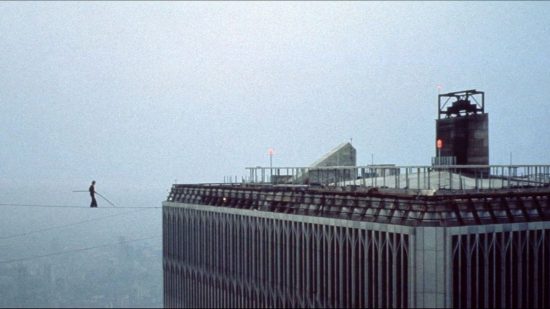On Movies: ‘Man on Wire’ is quite the balancing act
How often do you ask yourself “What movie can I watch?” and can’t find an answer? That film analysis essay was written by Primetimeessay team to help you with this problem.
On Aug. 7, 1974 – the day before Richard Nixon resigned the presidency – a 23-year-old Frenchman by the name of Philippe Petit did something extraordinary: Early that morning, he stepped out on a wire rigged between the tops of the Twin Towers at the World Trade Center in lower Manhattan and walked, without a net, sans harness, from one skyscraper to the other and back again. And back and forth – and fooling around in the middle – again and again.
Holding a balancing rod 1,350 feet in the air, Petit maneuvered along the inch-thick steel cable that he and his band of cohorts, after months of secret planning, had illegally anchored to the roofs. He danced along the wire for almost an hour. When he finally stepped off, the police were waiting for him.
“It was a wonderful kind of artistic event, and the twin towers provided the stage,” says James Marsh, the director of Man on Wire, the wild, inspiring documentary about Petit’s epic escapade. The film, winner of an audience award and a grand jury prize at the Sundance festival in January, opened Friday at the Ritz Five and Showcase at the Ritz Center/NJ.
Marsh, a Brit who has long lived in New York, read Petit’s book, To Reach the Clouds, in 2006 and was “absolutely captivated” by it.
“I knew the story, like many people who live in the city, just as an anecdote that you collect or absorb by living here. Almost like a folk memory,” says Marsh. “I thought it was just one of those stunts. But when I looked at the book and saw the photographs . . . and it was written in such a gripping way. You see all these impossible obstacles that presented themselves, that Philippe had to overcome. Not just the practical stuff – the smuggling of the equipment, the bow and arrows, the shackles, the grappling gear, the sort of medieval weaponry – but the mental dimensions. . . .
“And the fact that his life – well, Philippe would say it wasn’t at stake, but everyone else knows that it was.”
Marsh and producer Simon Chinn convinced Petit, who now lives in upstate New York, that they were the guys to tell his tale. Marsh uses interviews with Petit and his kooky gang of conspirators – his childhood sweetheart, a photographer, a musician, a WTC office worker, a stoner. The filmmaker incorporates archival footage and suspenseful, black-and-white reenactments of the key moments leading up to Petit’s walk.
It’s an awesome account of a death-defying act; a poetic portrait of the human spirit; and a captivating, real-life caper pic, to boot.
Man on Wire does something else, too: It returns the twin towers to life, and makes the World Trade Center stand for something other than terrible destruction.
“One of the things that struck me as I made Man on Wire . . . was that we were sort of re-creating a New York that I wished still existed,” Marsh says. “It’s all caught up in the destruction of the twin towers, ultimately. And that the world that event created, the world it creates at airports, the world it creates when you go into an office building – the world changed in many ways, and we allowed it to change. Our fears, in a sense, allowed us to submit to this new world order.
“And in fact the New York of 1974 and the World Trade Center walk is a world I’d much rather live in, I guess. There’s nostalgia about that, which maybe is a dangerous emotion, but nostalgia also has a kind of ache to it. . . .
“It does bring back and evoke this city that we are in danger of losing completely.”
At the same time, Marsh says he knew from the outset that he didn’t want to bring the events of 9/11 into the film in an overt or explicit way.
“I felt that the choice of not engaging with the destruction of those buildings was essential,” he explains, “because everybody’s going to be engaged with it anyway. It’s the big fact – the big documentary fact, if you like. It’s the defining fact, perhaps. . . .
“And the idea for me making the film was to get people not beyond it – how could you? – but at least to a point where you could enjoy the towers being built, and you could enjoy this sort of fantasy that’s being projected onto them by this obsessed Frenchman. . . .
“You see the buildings really almost exclusively through his eyes in the film, and that then becomes a legitimate way of bringing them back to life, I think. You’re seeing them through someone who knew them, knew their secrets and their secret noises, because he spent so much time there as they were being finished, as they were being built.”
Marsh, 45, has lived in New York for the last 14 years. Trained in documentaries, he made the controversial Gael Garcia Bernal/William Hurt drama The King, released in 2005. Although he flirts with fiction in the reenactments he shot for Man On Wire, he knew the film would always be a doc, with first-person accounts from the principals.
“If you told it as it was, with the people involved, you couldn’t do any better than that,” he says.
Marsh, married and with two children, is finally moving back to Europe. His next project is a feature based on the Yorkshire Ripper killings – serial murders that riveted Britain in the 1970s and ’80s. There will be three films, each from a different director. Julian Jarrold (the new Brideshead Revisited) and Anand Tucker (When Did You Last See Your Father?) are steering the other installments, all of them adapted from British novelist David Peace’s Red Riding Quartet.
“It’s a struggle to be a filmmaker in the U.S., and I’ve just given up on it now,” Marsh says with a laugh. “Man on Wire is a British film, it was funded by a British funding source, and everything I’ve done apart from The King – which was misery and tears on every level – has been funded out of the U.K.
“It’s almost perverse to keep pretending I’m an American filmmaker.”











This is pretty cool, I’ll follow up often!